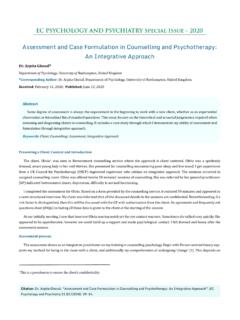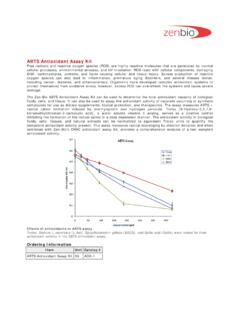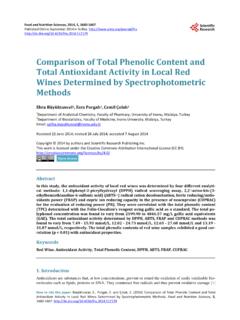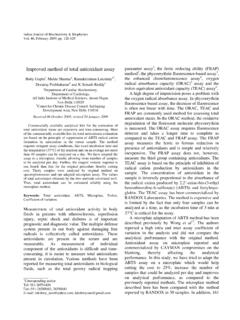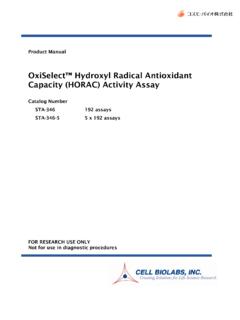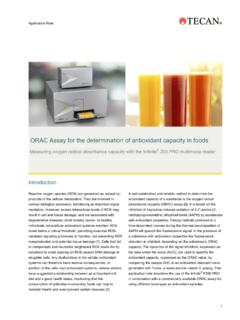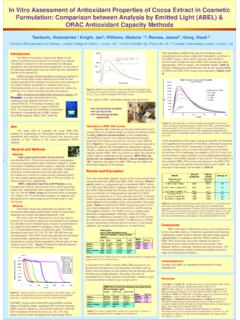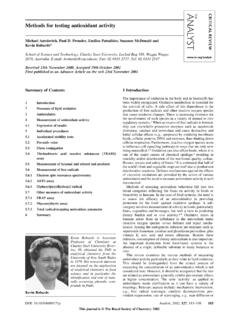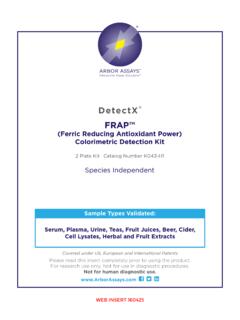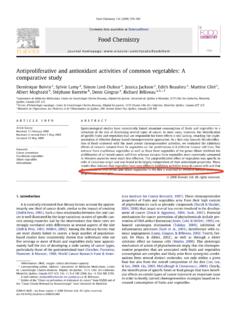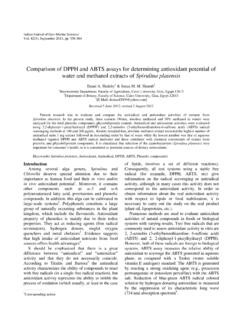Transcription of Cronicon OPEN ACCESS NUTRITION Research Article …
1 CroniconOPEN ACCESSNUTRITIONR esearch ArticleRevuelta Iniesta R1,2, Wilson DC2,3, Brougham MFH4, Smail NF1, Davidson I1 and McKenzie J11 Dietetics, NUTRITION and Biological Health Sciences, Queen Margaret University, Edinburgh, United Kingdom2 Child Life and Health, University of Edinburgh, Edinburgh, United Kingdom3 Department of Paediatric Gastroenterology and NUTRITION , Royal Hospital for Sick Children, Edinburgh, United Kingdom4 Department of Haematology and Oncology, Royal Hospital for Sick Children, Edinburgh, United KingdomReceived: October 02, 2015; Published: October 17, 2015*Corresponding Author: Raquel Revuelta Iniesta, Department Dietetics, NUTRITION and Biological Science Queen Margaret University, Queen Margaret University Drive, Edinburgh EH21 6UU, United of Plasma antioxidants , Oxidative Stress and Polyunsaturated Fatty Acids in Paediatric Cancer Patients: A Prospective Cohort Pilot StudyAbstractBackground: Paediatric cancer patients may have a limited dietary intake, particularly nutrients high in antioxidants , docosahexano-ic acid (DHA) and eicosapentanoic acid (EPA).
2 Objective: To investigate the antioxidant status (TAS), antioxidant capacity (TAC), oxidative stress, DHA and EPA of paediatric cancer patients during treatment. Methods: A prospective cohort study of Scottish children aged <18 years, diagnosed with and treated for cancer between April-2013 to Jan-2014 was performed. Clinical data and blood samples were collected at baseline and 6 months. Data were stratified by treat-ment risk (low, medium and high) and nutritional support. We used Oxygen Radical Absorbance Capacity (ORAC) antioxidant assay to measure TAC, thiobarbituric acid reactive substances (TBARS) for lipid peroxidation and high performance liquid chromatography and Inductively Coupled Plasma Mass Spectrometry for TAS. The analyses of DHA and EPA were performed by analysing fatty acid methyl esters (FAME) using gas-liquid chromatography. The reference ranges used were: Yagi 1998 ( ) mol for lipid peroxi-dation and Damsgaard.
3 , et al. 2014 for EPA ( ) % and DHA ( ) %.Results: 20 patients (median (IQR) age ( ) years; 50% males) were recruited. There were no significant changes in plasma TAS, TAC and EPA, but lipid peroxidation significantly decreased from ( ) at baseline to ( ) mol/MDA at 6 months (p = ). The median (IQR) blood percentage of DHA significantly increased from ( ) to ( ) (p = ). Lipid peroxidation was high in 95% (19/20) of patients at baseline and 94% (15/16) at 6 months; whilst DHA and EPA were low in 95% (19/20) and 70% (14/20) at baseline and (14/16) and 60% (12/16) at 6 months. Children on high-treatment risk exhibited the highest oxidative stress levels. No statitically significant differences were found between non-supplemented and supplemented children in any of the following parameters (TAS, TAC, oxidative stress, EPA and DHA). Conclusion: There was a high prevalence of oxidative stress, especially in children treated with high-risk protocols and during the initial phases of treatment.
4 Nutritional support does not appear to provide enough TAS, EPA and DHA in this cohort; however, larger high-quality population based studies are warranted to confirm these : Paediatric cancer; antioxidants ; Oxidative stress; Docosahexanoic acid; Eicosapentanoic acidCitation: Raquel Revuelta Iniesta., et al. Assessment of Plasma antioxidants , Oxidative Stress and Polyunsaturated Fatty Acids in Pae-diatric Cancer Patients: A Prospective Cohort Pilot Study . EC NUTRITION (2015): of Plasma antioxidants , Oxidative Stress and Polyunsaturated Fatty Acids in Paediatric Cancer Pa-tients: A Prospective Cohort Pilot Study413 Citation: Raquel Revuelta Iniesta., et al. Assessment of Plasma antioxidants , Oxidative Stress and Polyunsaturated Fatty Acids in Paediatric Cancer Patients: A Prospective Cohort Pilot Study . EC NUTRITION (2015): rates of paediatric cancer patients have improved considerably in the last 40 years with the implementation of more inten-sive and progressive treatments.
5 Consequently, attention is shifting to the reduction of treatment related side-effects during and after completion of therapy [1]. At present, there is a great deal of interest in the benefits of antioxidants and polyunsaturated fatty acids (PUFA), particularly docosahexaenoic acid (DHA) and eicosapentaenoic acid (EPA), on health. Both have been demonstrated to possess anti-inflammatory properties and may therefore protect against endothelial cell senescence (aging) [2], early cardiovascular disease (CVD), neurodegenerative disorders and cancer [3,4], of which survivors of paediatric cancer are at increased risk compared to the general population [1,5].Free radicals (FR) at low/moderate concentrations are essential for normal body functions [6]. FR are involved in cell signaling, are bactericidal in response to infection and are also secreted as by-products in mitochondrial respiration playing an essential role in homeostasis [6].
6 Cancer generates high levels of FR induced by an inflammatory response. In addition some cancer treatments including chemotherapy, such as alkylating agents and anti metabolites, and radiotherapy generate FR to induce cancer-cell apoptosis [3]. This in turn may lead to oxidative stress [7] by promoting lipid peroxidation, oxidative mediation of proteins and by damaging nuclear and mi-tochondrial DNA [8,9]. Excess production of FR damages both cancer cells and healthy tissues [10]. Some authors [10-13] have reported that higher levels of total antioxidant status (TAS) and total antioxidant capacity (TAC), which is the cumulative action of the antioxidants present in plasma [11], may be beneficial and counteract some of the toxic effects of FR, thus reducing treatment related side-effects and improving clinical outcome in children with ALL. Despite the potential protective role of antioxidants and -3 PUFA against the development of CVD, neurodegenerative disorders and cancers, until now no studies have investigated the profile of TAS, TAC and markers of oxidative stress as well as plasma PUFA levels in paediatric cancer patients.
7 In addition, nutritional profile in current clinical practice usually only consists of growth assessment, routine biochemical and haematological blood tests. However emerging evidence suggest that plasma TAS, TAC, markers of oxidative stress and lipid levels may provide a further indicator of nutrient adequacy and nutritional functional markers [3,16,18,19]. Therefore, the aims of this study were: (i) to assess the TAS, TAC and oxidative stress as well as the lipid profile in paediatric cancer patients at diagnosis and 6 months into treatment; (ii) to establish whether there were any changes in these parameters following 6 months of treatment (iii) and whether there were any differences between children who were on nutritional support compared to those who were not. The polyunsaturated fatty acids omega-3 ( -3 PUFA) and omega-6 ( -6 PUFA) are essential as they need to be supplied from the diet [14]. Linoleic acid, the most abundant -6 PUFA in the western diet, is a precursor of arachidonic acid (AA).
8 AA is a potent precursor of inflammatory markers [14] whereas, the main -3 PUFAs are DHA, EPA and -linolenic acid (14). Both DHA and EPA are anti-inflam-matory fatty acids [14,15]. A balance between -3 PUFA and -6 PUFA is necessary for homeostasis of the immune system and optimal body and brain development. This is particularly important in younger children [16]. Supplementation of -3 PUFA, particularly DHA, has been shown to induce neuroblastoma cell death in vitro [17] and in vivo [16]; whilst, excessive AA may promote tumour promotion and progression [14,15]. IntroductionMethodsAbbreviations: AA: Arachidonic Acid; ALL: Acute Lymphoblastic Leukaemia; BMI: Body mass index; DHA: Docosahexaenoic acid; EPA: Eicosapentaenoic acid; FAME: Fatty acid methyl esters; FR: Free radicals; HPLC: High performance liquid chromatography; MDA: Malondialdehyde; ORAC: Oxygen Radical Absorbance Capacity; PUFA: Polyunsaturated fatty acids; ss-CRP: Standard sensitivity C-Reac-tive Protein; TAC: Total antioxidant capacity; TAS: Total antioxidant status; TBARS: Thiobasbituric Acid Reactive Substances; TE: Trolox equivalentsA prospective cohort pilot study was performed.
9 The eligibility criteria were: (i) children aged < 18 years; (ii) diagnosed with cancer (ICCC-3) [20] or Langerhans Cell Histiocytosis between April-2013 to Jan-2014; (iii) attending the South East Scotland regional centre for Haematology and Oncology at the Royal Hospital for Sick Children (RHSC), Edinburgh for treatment. We excluded children who were Assessment of Plasma antioxidants , Oxidative Stress and Polyunsaturated Fatty Acids in Paediatric Cancer Pa-tients: A Prospective Cohort Pilot Study414 Citation: Raquel Revuelta Iniesta., et al. Assessment of Plasma antioxidants , Oxidative Stress and Polyunsaturated Fatty Acids in Paediatric Cancer Patients: A Prospective Cohort Pilot Study . EC NUTRITION (2015): collection, procedure and analysis of samplesThe following clinical data was collected: diagnosis, treatment intensity stratified according to Kazka., et al. [21] into low, medium and high risk (intensity) [21] and length of treatment.
10 Biochemical blood parameters (standard sensitivity C-Reactive protein (ss-CRP)) and demographic data (age, gender, ethnicity and socio-economic deprivation) were also collected from the medical notes. As a proxy marker for socioeconomic deprivation, we used individual residence postcodes to assess deprivation level of areas of residence using the Standard Index of Multiple Deprivation (SIMD) [22]. The paediatric cancer cohort was grouped according to the wider definition of solid tumours, haematological cancers, brain tumours and other associated diagnoses. Height (or length) and weight were measured using standard procedures (RRI). BMI centile was calcu-lated and UK BMI growth centiles were used. Nutritional status was classified as underweight (BMI centile) and overweight (BMI 85th) [23].TAS was assessed by measuring vitamin A, vitamin E/Cholesterol (E/Ch) and the trace metals zinc, copper and selenium. Blood samples were collected by trained nurses.
